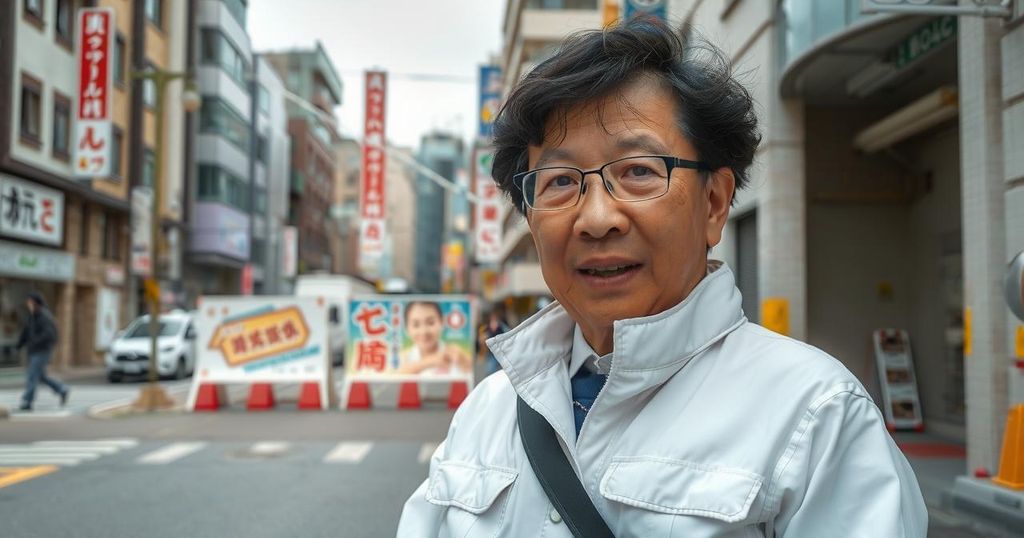Kobe Employee Strives to Enhance Disaster Preparedness Following Noto Quake
Kobe City employee Masayuki Fujisawa, dispatched to Suzu, Ishikawa Prefecture, post-Noto Peninsula Earthquake, aims to use his experiences to enhance disaster preparedness in Kobe. Having witnessed extensive destruction, he emphasizes the importance of practical readiness for natural disasters, drawing from his upbringing during the 1995 Great Hanshin Earthquake.
A dedicated employee from Kobe City, Masayuki Fujisawa, has been working tirelessly in Suzu, Ishikawa Prefecture, as a support worker following the devastating Noto Peninsula Earthquake. His experience serving in a severely affected area has deeply influenced his resolve to enhance disaster preparedness in his hometown of Kobe. Having been born just weeks before the Great Hanshin Earthquake in 1995, Fujisawa is acutely aware of the long-term impacts of such disasters on communities and families. Throughout his year in Suzu, he faced unimaginable devastation, witnessing the destruction of homes and the disruption of lives caused by the earthquake’s aftermath.
During his time in Suzu, Fujisawa’s responsibilities included managing public relations and facilitating communication for disaster relief efforts. He actively participated in local outreach, ensuring that vital information regarding support programs reached earthquake victims. This involved visiting temporary housing facilities to distribute newsletters to those affected, an effort that he undertook even in adverse weather conditions. His personal connection to the trauma of the Hanshin Earthquake has propelled him to emphasize the necessity of disaster preparedness back in Kobe, advising that a more vivid and practical understanding of potential emergencies is crucial for residents.
The Noto Peninsula Earthquake, occurring a year prior to the present date, led to extensive destruction, leaving approximately 3,800 structures either completely or partially damaged. Fujisawa compared experiences of the current disaster to the 1995 earthquake when he shared news of the devastation with his father, who noted the similarities in disbelief and trauma.
Prior to his dispatch in Suzu, Fujisawa had pursued a public service career with aspirations of contributing positively to his home city after gaining experience in other local government roles. As he transitions back to Kobe, he aims to leverage his firsthand encounters in Suzu to cultivate a sense of urgency surrounding disaster preparedness among residents. With the anniversary of his 30th birthday aligning with the 30th anniversary of the Great Hanshin Earthquake, he expresses a firm commitment to educating others about the significance of being well-prepared for emergencies. His perspective is shared by many in the recovery community, where over 566 support workers from various municipalities are currently providing assistance to disaster-heavy regions in Japan.
The article focuses on the experiences and motivations of Masayuki Fujisawa, a Kobe City employee who served as a support worker in Suzu, Ishikawa Prefecture, following the Noto Peninsula Earthquake. Understanding the deep impacts of major seismic events, he intends to apply the lessons learned in Suzu to advocate for better disaster preparedness in Kobe. The context interweaves Fujisawa’s personal history with both the Great Hanshin Earthquake and the challenges faced by disaster-stricken communities seeking recovery and restoration.
Masayuki Fujisawa’s commitment to advocating for disaster preparedness reflects a broader understanding of the importance of community resilience following significant seismic events. By leveraging his experiences in Suzu to inform residents of Kobe, he emphasizes the need for practical readiness and awareness. With a dedicated workforce of support staff assisting in recovery efforts throughout Japan, collective experiences can shape future initiatives aimed at safeguarding communities against the uncertainties of natural disasters.
Original Source: japannews.yomiuri.co.jp




Post Comment